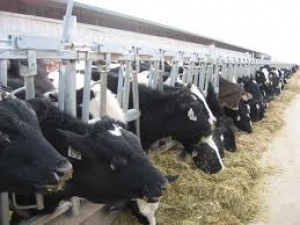Heat stress and cooling systems for dairy cows
Look out for Signs of Heat Stress

Dairy cows are more sensitive to heat stress than many other mammals because of the high metabolic heat production due to fermentation in the rumen.
Dairy cows experiencing heat stress show higher rectal temperatures, increased respiration rates, decreased feed intake, decreased milk production (volume and components) and other health problems (e.g., decreased reproductive efficiency). As milk production increases, heat production from the rumen increases and makes cows even more susceptible to the unfavourable effects of heat stress.
Over the years researchers found the effects of heat stress were a function of both temperature and relative humidity. Thus, the temperature-humidity index (THI) was developed to determine when cows would begin to show the symptoms of heat stress. Researchers developed a chart that expressed the intensity of heat stress as a function of these two parameters.
However, the research that developed this chart was performed between 1955 and 1965 when dairy cows only averaged 35 to 50 pounds of milk per day. Today’s modern dairy cow easily produces double that amount. Since metabolic heat production by the cow is related to increased feed intake and milk production new research has been performed to revise the THI chart.
Formerly heat stress research suggested that the threshold for cows to experience mild heat stress was 72 degrees F. However, newer research suggests that mild heat stress can begin with temperatures as low as 65 degrees F.
“Quantifying Heat Stress and Its Impact on Metabolism and Performance" is a paper that points out milk yield losses become significant when the minimum THI on any given day is 65 or higher.
The research found that when the minimum THI is between 65 and 73 milk yield loss is almost 5 pounds/cow per day. Although not reported in the paper, it is expected that milk component percentages will also be lower. This paper contains a valuable colour chart showing the intensity of heat stress as a function of temperature and relative humidity. This chart is based on the latest heat stress data using high producing dairy cows, thus, is directly applicable to commercial dairy producers.
Heat-stress abatement is a critical dairy-management strategy. Since it has been found that the harmful effects of heat stress begin at lower temperatures than previously thought all dairy producers should consider employing heat-stress abatement strategies at lower temperatures, especially for groups of high-producing cows.
Producers are recommended to take appropriate heat-stress-abatement strategies when appropriate to minimise loss of milk volume and milk components and decrease the other adverse effects of heat stress on their dairy herd.






















